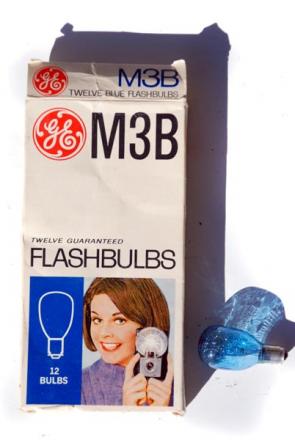Magnesium
A shot in the Dark
Magnesium was once ubiquitous as a source of illumination in flash photography. As domestic camera markets have changed, so many flashbulbs find themselves bundled away free with a camera on many a car-boot table. People tend to overprice them, remembering that they were single use and therefore added a great expense to each bulb used.
Flashbulbs like these pictured are still sought out by cave photography enthusiasts as they pack a real punch, but this is a relatively small market compared to their halcyon days. Magnesium is also a major component of signal flares and sparklers for the same reason.
Essentially they all work under the same principle: a glass bulb, filled with oxygen and aluminum or zirconium wire or foil, which, when ignited electrically, burns with a brilliant flash to provide momentary illumination of a subject.
These have a blue dot (cobalt chloride) which turned pink if the bulb was cracked or damaged by moisture, alerting the user to the possibility of the bulb shattering on use, or so the marketable myth goes.
Sylvania bulbs, which may have been made in the same factory, had a marketing slogan "...blue dots for sure shots"; or something to that effect. The Sylvania version has the same lady as GE’s on the packaging, but with less of a toothpaste grin. In any event the guarantee was only valid in the United States.
Milky Sea of Magnesia
Today, magnesium can be extracted from the minerals dolomite and carnallite, but is most often obtained from seawater. Every cubic kilometer of seawater contains about 1.3 billion kilograms of magnesium. As such, it’s much more cost effective than trying to extract gold using this process.
When combined with water (H2O), magnesia forms magnesium hydroxide (Mg(OH)2), better known as milk of magnesia, which is commonly used as an antacid and as a laxative.
Hydrated magnesium sulphate, better known as Epsom salt, was discovered in 1618 by a farmer in Epsom, England, when his cows refused to drink the water from a certain mineral well. He tasted the water and found that it tasted very bitter. He also noticed that it helped heal scratches and rashes on his skin. Epsom salt is still used today to treat minor skin abrasions.
